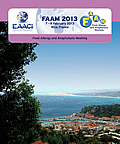BENEFITS OF USING HEATED EGG (HE) IN THE MANAGEMENT OF EGG ALLERGY.
A. Claver, E. Botey, B. Navarro, N. Depreux, A. Cistero-Bahima

ALLERGY DEPARTMENT.
USP INSTITUTO UNIVERSITARIO DEXEUS.
UAB. BARCELONA, Spain
BACKGROUND:
Previous studies suggest that extensive heating and food matrix diminish the allergenicity of egg white proteins, making it possible to be tolerated by some children with egg allergy.
METHODS:
50 patients (table 1) underwent an OFC with HE performed in two different days. The first day began with gradual doses of cookies (a brand containing egg) and later home-breaded chicken. Subsequently, tolerant patients incorporated HE into their diet (cookies or food products containing egg daily and home- breaded foods 2-3 days/week). A second challenge with gradual doses of a serving size of a home-made cake containing 4 eggs was performed a week
later. Regular consumption was advised for tolerant subjects. All children were periodically controlled. Factors including SPT and sIgE levels, psychological and others were used to determine a subsequent challenge with less-heated-egg (hard-boiled egg, omelette and raw consecutively)
TABLE 1: BASELINE CLINICAL CHARACTERISTICS
| Gender | 32 male/18 female |
| Mean Age (y;range) | 5.7 (0.5-16) |
| History of immediate reaction | 50 (28 anaphilaxys, 13 cutaneous, 9 gastrointestinal) |
| Mean SPT to ovomucoid (OVM) and raw egg withe (EW) (mm;range) | OVM: 7.39 (0-18.5) EW: 10.7 (5.5-18.5) |
| Mean OVM and EW sIgE levels (KU/L; range) | OVM: 8.86 (0.1-100) EW: 11.53 (0.1-100) |
RESULTS:
100% of patients tolerated cookies (2-4 units). 90% (45/50) tolerated breaded chicken in the first OFC; 2 patients presented mild anaphylaxis (1 adrenalin dose was required) and 3 mild abdominal pain treated with oral antihistamines.
They were instructed a regular cookie intake and 3 were successfully re-challenged a month later. 91.6% (44/48) tolerated cake. 4 patients presented mild abdominal pain. In the next 6-12 months 72 % (36/50) underwent an OFC with hard-boiled egg (negative in 29/ 5 gastrointestinal symptoms/1 cough/1 angioedema). 30% were challenged with omelette (14 passed/1vomiting) and 12% with raw egg (all 6 passed). During the home dosing, 20% presented mild
abdominal pain with excellent response to oral antihistaminic (50%of which later achieved hard-boiled egg tolerance).
SPT wheal diameter to OVM and raw egg white and OVM sIgE levels decreased significantly from the baseline in patients tested. All patients, including the 2 that only tolerated cookies, reported a substantial improvement in quality of life
CONCLUSION:
HE is well tolerated and safe. Thus, strict dietary avoidance may not be necessary at any stage of the protocol, including at the start.
